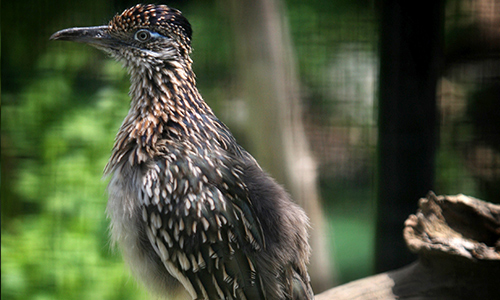Appearance:
Roadrunners are members of the cuckoo family. Male and female roadrunners are similar in appearance. They have dark back and wing feathers with brown and white streaks. The neck, chest and belly are pale, and their long tail is often held up at an angle. Their head is spotted and they have a crest that can be raised and lowered. Roadrunners have long legs with two toes facing forward and two toes facing backward, making tracks that look like X's.
Size:
- Length: 20–24 inches
- Weight: 0.5 -0.75 pounds
- Wingspan: 17–22 inches
Reproduction:
Female roadrunners lay between three to six eggs over a period of days, staggering the hatching of young, which is known as asynchronous hatching. Incubation of eggs last for 18 to 20 days, during which the female sits during the day and the male at night, as males are able to maintain their body temperature. Offspring compete for food and older, larger roadrunners will always benefit if food is scarce as they crowd out the smaller chicks. Roadrunner chicks fledge after 18 to 24 days.
Median Life Expectancy:
Roadrunners have an average life expectancy of seven to eight years.
Habitat/Range:
The roadrunner inhabits open, flat or rolling terrain with scattered cover of dry brush. They also inhabit chaparral, desert scrub, and woodlands in the southwestern part of the United States.
Diet:
Roadrunners mostly eat insects, reptiles or amphibians. Occasionally they will eat small mammals, birds and eggs.



